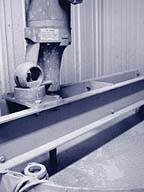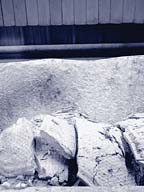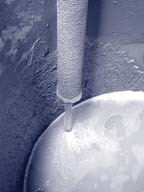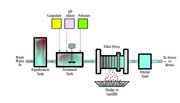Paint Wastewater Compliance

The contaminants under greatest regulatory scrutiny in paint wastewater streams are total suspended solids (TSS), and to a somewhat lesser extent, heavy metals, biological oxygen demand (BOD) and chemical oxygen demand (COD). The exceptionally high levels of TSS that in part account for a coating's performance, come back to present the most significant disposal obstacle in more ways than one. Without treatment, a clogged water line on the premises becomes an immediate production problem that is expensive, dirty and time-consuming to correct. Untreated wastewater that does reach POTW facilities are met with tightening discharge standards and escalating surcharges. In a worst-case scenario that is all too common, when untreated wastewater results in obstructed lines somewhere between the origin and the destination, the disposal problem is instantly transformed into an infrastructure problem, and decisions begin to be made beyond the control of the facility that is out of compliance.
All these factors, in combination with pollution-control technologies that have simultaneously become more user friendly, more effective and more affordable, have made on-site treatment a viable option for a growing number of paint wastewater generators. By and large, they recognize that today's coatings are just too good to keep hoping "dilution is the solution to pollution." They also recognize the significant potential for creating a resource management system that lowers certain costs, such as those for incoming fresh water within a design that emphasizes reuse and recycling. That counts for something in an economy that equates cost control with revenue generation.
The exceptionally fast settling rate of coating wastewater, in tandem with its adhesive qualities, all but eliminate purely mechanical means of separation. In response to the complex compounds of waterborne paints, some variation of physical-chemical treatment is practically the norm in the separation process.
Phys-chem treatment has in many ways advanced in lockstep with - if not paced - the development of waterborne coatings. From a treatment perspective, these waste streams behave similarly to those of the printing industry, where flexographic inks, adhesives and heavy metals are all present, and where manufacturers like ourselves have been active since the 1970s.

In all cases, the goal is to optimize quality of water for discharge or reuse, and convert the paint material into a sludge that can be dehydrated or ‘dewatered' - ideally to a range of 35% - 50% (by weight) waste solids - and disposed of cleanly, neatly and safely. The most common phys-chem approach is some variation of our Batch Filter Press wastewater treatment system, which utilizes polymer and coagulant to cause contaminants to coalesce into a floc separable from water. After the chemical cycle, the floc is transferred to a Hy-Pack filter press, a pressurized plate-and-frame design that is able to manage the larger particulate sizes of paint and coating waste streams with minimum upsets. This technology produces a dry, highly compacted filter cake that in most cases is locally landfillable.
It should be noted that the very introduction of chemistry, coagulant in particular, contributes its own part to the equation. Contaminants in the form of dissolved solids may need to be addressed in certain concentrations or geographic locations. This is something that has become more of an issue in states such as California and Texas, where discharge limits for dissolved solids have tightened dramatically. Depending on levels of BOD and dissolved solids, biological treatment may occasionally be warranted.
For our part, we have focused on mechanical engineering to reduce paint's natural tendency toward BOD formation throughout the pretreatment stages (mixers, aerators and the like), and chemical engineering to develop blends and precoats that significantly reduce dissolved solids and sludge production. Our experience with a class of chemical blends called ‘polymacs' has allowed us to develop effective and cost-efficient treatment schemes for paint that replace standard aluminum sulfates, aluminum chlorides and the range of coagulants that reduce solids with salt.

- 1. Many degrees of automation are available and should be considered in light of the customer's comfort level with wastewater treatment. A system equipped with a Programmable Logic Controller (PLC) can make virtually all chemical and engineering decisions, but realistically assess general housekeeping practices, labor allocation, etc. Though not unduly fragile, PLCs are sensitive instruments that require routine maintenance for optimal performance. Beyond simply running the system, they can also be fitted with modules that allow precise tracking of chemical consumption and treatment histories, communications with off-site technical support, and other helpful functions.
2. Consider a chemical service program to back any equipment purchase. For most paint and coating wastewaters, proper dilution should keep chemical costs in the range of $0.05 - $0.08 per gallon treated. Above that range, there is a strong possibility that imbalances exist that can easily be corrected by performing a chemical audit that evaluates treatment logs, preparation and handling, and suitability for multiple, variable waste streams over time.
3. Treatment system expandability is an important consideration, not only to meet increasing wastewater volumes within growing companies, but also to remain flexible and responsive to future regulatory and plant process changes.
4. The reuse of treated paint water is completely achievable and should be part of any system plan. At the least, treated water may be used for dilution of a batch, and under certain circumstances is also suitable for use as a first rinse in the wash down process. The possibility of effectively treating other waste streams beyond paint wash water, such as floor scrubber water, waterborne glues used in any packaging operations, and the like should also be explored.
5. Encourage and expect a partnership approach between your company, your local POTW, and your wastewater treatment system supplier. A responsible regulatory agency will have an interest in helping assure your success with a wastewater challenge, and can provide invaluable technical and procedural resources. Similarly, early involvement of the treatment system supplier should pay dividends by way of permitting assistance, comprehensive treatability studies, and reliable cost-to-treat projections.
Many factors will influence a treatment system's ability to meet or exceed these general guidelines and parameters, but the point is that wastewater treatment systems to manage disposal have come a long way.

From Lumberyard to Environmental Model
The recent history of Edmund Allen Lumber Co., of Momence, IL, provides an excellent example of how several different paint industry, regulatory policy and market forces can converge to create a central role for wastewater disposal in business operations. The 105-year-old company, an early pre-finisher with its first staining machine installed in 1961, today is counted among the largest cedar wholesalers in the country. E.A. Lumber also has coating operations engaged in the production of wood sidings and moldings, engineered board, fiber cement and other building products.Like many others in their business, the firm saw the mid-1990s as the turning point for a shift toward accelerating commercial use of waterborne coatings, moving from about 10% of all coatings used to about 60% currently. Simultaneously, the unprecedented housing boom brought a nearly eight-fold increase to the company's coating throughput, from 2.6M board feet in 1994 to 19.6M board feet currently. Translated to wastewater in need of disposal, they now generate approximately 17,000 gallons monthly.
By the turn of the millennium, E.A. Lumber decided to commit to on-site wastewater treatment and eliminate the risk of compromising an established, environmentally proactive corporate identity, and the chance of negatively impacting on public works, not to mention bi-monthly sewer line rodding and haul-out charges that approached $3,000 each. Not surprisingly, the main concern was suspended solids.
Ken Ford, E.A. Lumber's president, relates that, "We're in a business that just can't afford downtime due to a wastewater issue. When we looked at treatment options, we really had to consider not only the quality of water that we could produce, but also the role that on-site wastewater treatment might play in strategic planning...things like expanding capacity because you can now handle higher volumes coming out of the paint lines. We didn't necessarily want to become pollution control experts, and so good guidance and minimal operator time and knowledge requirements were also fairly important."
Beckart Environmental evaluated the firm's needs and recommended a 1200-gallon Batch Filter Press treatment system based on several factors. The nature of E.A. Lumber's business - extremely time-sensitive and producing widely varying waste streams - dictated a design with a capacity to handle frequent washdowns from JIT delivery commitments and multiple color switchovers. The system was designed from the start to produce water suitable for reuse, with each batch of incoming raw wastewater free to use treated water from previous batches to achieve optimal dilution ratios prior to chemical treatment.
This type of design, in combination with lab and field experimentation to build an effective and efficient chemical regimen, keeps cycle times relatively brief. With five flood-and-brush coating machines running two shifts currently, the firm is now capable of processing three batches of wastewater daily, if necessary.
As with most coating wastewater streams, it was determined that dilution would be necessary, at a rate of at least 1:1 if not 2:1. Before long, it was evident that the great variety of products used from different coating manufacturers resulted in multiple waste streams that behave differently under treatment, and a 2:1 dilution standard was established as a safeguard.
Nearly the entire treatment system, from dilution measurement at start-up through the sludge transfer stages in the filter press cycle, is governed by a programmable logic controller. Operator time is limited to routine housekeeping and occasional manual overrides, such as when more clean water is on hand than necessary and a valve is opened for sewer discharge.
Since the treatment system's installation, E.A. Lumber has not been out-of-compliance for suspended solids. The company pays a small POTW surcharge (about $40 monthly) for BOD, contained primarily by electro-mechanical devices that keep the water "lively" and BOD resistant.
"One of the huge advantages for us with this wastewater treatment system," Ford says, "is that we can continue to produce a waste stream throughout the day, and then batch cycle it at our convenience. We even have backup holding tanks so that if we get very busy very suddenly - again, quick turnaround is the name of the game in our business - we can continue with our washes and then get caught up on the treatment end later. Plus, we had experience with Beckart from a very small system we bought years ago. They're a firm that revolves around relationship sales, and it shows in their service. We're very satisfied."
For more information, contact John Carter, Beckart Environmental, Inc., 6900 46th St., Kenosha, WI 53144; e-mail jbeckart@cs.com; or visit www.beckart.com.
Process Description
This process flow diagram outlines the major components of a Batch Filter Press wastewater treatment system. Depending on the application, these systems may also include clean-water holding tanks and reserve filtrate water tanks for recycling and reuse (as is the case with the coating lines at Edmund Allen Lumber), as well as sludge-handling equipment and accessories as desired.- A.) The process begins with wastewater periodically transferred at a fixed volume into the chemical treatment tank. When necessary, treated water from the clean-water holding tank is added to dilute the waste material to precipitate the suspended solids more effectively. The wastewaters collected in the equalization tank are kept in suspension with a mechanical mixer; an air sparge assembly may be used in place of or in addition to the mixer for agitation. It is recommended that a mechanical mixer be used as coatings separate rapidly and will clog any small diameter pipe or opening without proper mixing prior to treatment.
B.) System start-up activates the chemical treatment tank mixer and sludge/recirculation transfer pump. Treatment chemicals are automatically added sequentially, beginning with coagulant to break the emulsion in the water. The pH controller adds sufficient pH adjustment fluid to make the stream suitable for discharge into the POTW. Finally, the addition of polymer enlarges the floc formation for filtration.
C.) The final phase of the process, the filtration cycle, begins with a precoating of the Hy-Pack® filter press to prevent the tackiness of the paint from blinding the filter assembly. An automatic control system arranges the valve positions of the three-way ball valves to transfer the contents of the chemical treatment tank into the press. The recirculation/sludge transfer pump is activated, allowing the press to capture the floc complex and form a filter cake. The clean, treated water flows through the forming filter cake and passes through the filter cloth. That water travels through the collection channels in the filter press and is transferred to a filtrate holding tank. A level-controlled transfer pump periodically empties the contents of the filtrate holding tank into the clean-water holding tank. An automatic control system will sequence the operating air pressure to the recirculation/sludge transfer pump to obtain the optimal fluid flow rate through the press.
Looking for a reprint of this article?
From high-res PDFs to custom plaques, order your copy today!





